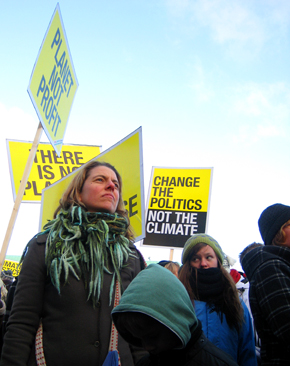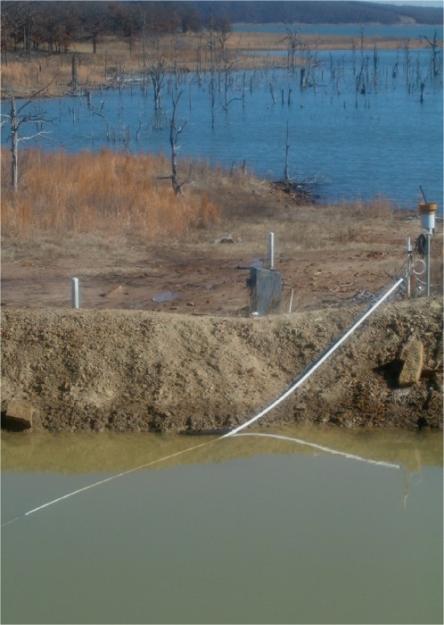What Is the IPCC Telling Policymakers About Climate Change and Water?
Oceans are rising faster and becoming more acidic, snowpack is decreasing, and the Earth is heating up.
The latest report on climate change from an international panel of scientists is a story of epochal transformations to the Earth’s land, air, and water systems. Greenhouse gas concentrations in the atmosphere are the highest in 800,000 years, and the rate of sea level rise since the Industrial Revolution is the highest in the last two millennia.
Since its last report in 2007, the Intergovernmental Panel on Climate Change, which works at the bequest of national governments, says that humans are almost certainly the “dominant cause” for the warming that has happened in the last century.
Today, the IPCC submitted its summary for policymakers and a list of 19 key messages. The panel’s full report will be released on Monday.
The policymakers’ summary includes conclusion statements for each section and a set of supporting statements. What does the summary say about water? Many of the effects of climate change will be felt through changes to water – changes to the water cycle, to precipitation, to glaciers, and to the seas.
Below, you will find the water-related conclusions and supporting statements and an explanation of what they mean.
Note: Besides describing the climate effects, some of the statements contain a dose of science-speak. One set of words is a measure of confidence in the assessment, which is expressed in a range from very low to very high. The other is a measure of certainty, from exceptionally unlikely to virtually certain.
The report also refers to Representative Concentration Pathways (RCPs). These are the four carbon-emissions scenarios used to model the future. The low-emissions scenario, called RCP 2.6, reflects a future in which limits have been placed on greenhouse gases and renewable energy is widespread. The high-end scenario, called RCP 8.5, means a coal- and oil-powered economy lives on. Because carbon dioxide builds up in the atmosphere, all the scenarios have higher projections than the current concentration of roughly 396 parts per million.
Sea Level Rise
Conclusion: Global mean sea level will continue to rise during the 21st century. Under all RCP scenarios the rate of sea level rise will very likely exceed that observed during 1971–2010 due to increased ocean warming and increased loss of mass from glaciers and ice sheets.
What It Means: One of the headline changes in the new IPCC report is the higher projections for sea level rise, due in part to better measurements. The range is now projected at 26 to 82 centimeters (10 to 32 inches), up from the 18 to 59 centimeters (7 to 23 inches) in the 2007 report.
This is the average global rise; local effects will vary. Net sea level rise is the important number, a calculation that takes into account what the land is doing. Some areas where the land is rising after shaking off the weight off glaciers, such as the Pacific Northwest, might see less net sea level rise than the global average. Regions such as Louisiana where the land is subsiding or shrinking due to groundwater pumping or coastal erosion will be worse off.
Supporting Statement #4: Based on current understanding, only the collapse of marine-based sectors of the Antarctic ice sheet, if initiated, could cause global mean sea level to rise substantially above the likely range during the 21st century. However, there is medium confidence that this additional contribution would not exceed several tenths of a meter of sea level rise during the 21st century.
What It Means: The Antarctic ice sheet is the big unknown, David Bromwich told Circle of Blue. Bromwich is the director of the Polar Meteorology Group at the Byrd Polar Research Center and an IPCC contributing author. Parts of the Antarctic ice sheet are categorized as “marine” ice sheets, meaning the land they rest on is a bowl-shaped depression slightly below sea level.
The only way the oceans rise above the IPCC’s projections for sea level rise by 2100 is if the Antarctic marine ice sheets start disintegrating. That would happen if the oceans rise enough that sea water, warmer than ice, gets into the bottom of the bowl. This has not yet happened and Bromwich said that a complete melting would take hundreds or thousands of years. But in the short-term such an event could trigger greater sea level rise than expected, by roughly one foot. Again, Bromwich is cautious. “Nobody really knows what would happen,” he said. “It’s an experiment we don’t want to make.”
Water Cycle
Conclusion: Changes in the global water cycle in response to the warming over the 21st century will not be uniform. The contrast in precipitation between wet and dry regions and between wet and dry seasons will increase, although there may be regional exceptions.
What It Means: There’s not much new here. The rule of thumb for climate change’s effect on the water cycle is that dry areas will become drier and wet areas wetter.
Supporting Statement #1: Projected changes in the water cycle over the next few decades show similar large-scale patterns to those towards the end of the century, but with smaller magnitude. Changes in the near-term, and at the regional scale will be strongly influenced by natural internal variability and may be affected by anthropogenic aerosol emissions.
What It Means: The biggest changes come later this century. For now, natural patterns, like the El Nino-Southern Oscillation and the Pacific Decadal Oscillation, dominate.
Supporting Statement #2: The high latitudes and the equatorial Pacific Ocean are likely to experience an increase in annual mean precipitation by the end of this century under the RCP8.5 scenario. In many mid-latitude and subtropical dry regions, mean precipitation will likely decrease, while in many mid-latitude wet regions, mean precipitation will likely increase by the end of this century under the RCP8.5 scenario.
What It Means: Again, the wet areas get wetter and the dry areas drier. However, there are some changes in this report based on new research and modeling since the last report in 2007. In the United States, the amount of precipitation expected in the Southwest is now on the border between wetter and drier, whereas in previous reports the region was expected to be drier. Even so, any increase in precipitation in the Southwest could be offset by increasing evaporation from higher temperatures so that soil moisture is ultimately reduced, says Linda Mearns a climate scientist at the National Center for Atmospheric Research and a review editor for the IPCC report.
Supporting Statement #3: Extreme precipitation events over most of the mid-latitude land masses and over wet tropical regions will very likely become more intense and more frequent by the end of this century, as global mean surface temperature increases.
What It Means: Extreme events, like the Boulder floods earlier this month, are a force. They overwhelm both river beds and sewer systems. Because a warmer atmosphere holds more moisture, these extreme rains are expected to increase. Most of the world’s population lives in the mid-latitudes and wet tropical areas, so we’re in this boat together.
Supporting Statement #4: Globally, it is likely that the area encompassed by monsoon systems will increase over the 21st century. While monsoon winds are likely to weaken, monsoon precipitation is likely to intensify due to the increase in atmospheric moisture. Monsoon onset dates are likely to become earlier or not to change much. Monsoon retreat dates will likely be delayed, resulting in lengthening of the monsoon season in many regions.
Supporting Statement #5: There is high confidence that the El Niño-Southern Oscillation (ENSO) will remain the dominant mode of interannual variability in the tropical Pacific, with global effects in the 21st century. Due to the increase in moisture availability, ENSO-related precipitation variability on regional scales will likely intensify. Natural variations of the amplitude and spatial pattern of ENSO are large and thus confidence in any specific projected change in ENSO and related regional phenomena for the 21st century remains low.
What It Means: The El Nino-Southern Oscillation is a cyclical warming of the surface waters in the eastern Pacific Ocean near the equator. Every few years the warm waters turn cooler and we get a La Nina. An El Nino event brings dry days to eastern Australia, the Amazon Basin, and Central America, while delivering wetter winters in the U.S. Southwest.
As the IPCC statement says, these warm-cold cycles are the dominant force on weather patterns in the Pacific hemisphere and are expected to get stronger due to the increase in the amount of water vapor in the atmosphere.
Cryosphere (aka The Ice Realm)
Conclusion: It is very likely that the Arctic sea ice cover will continue to shrink and thin and that Northern Hemisphere spring snow cover will decrease during the 21st century as global mean surface temperature rises. Global glacier volume will further decrease.
What It Means: A decline in spring snow cover will have serious repercussions for water managers and agriculture. To this point, the snowpack has acted as a natural reservoir that releases water in the summer when rainfall is scarce. A reduced snowpack will lead to arguments for more water storage, either in new surface reservoirs or below ground in aquifers. Hydropower generation will decrease in summer months – a time when demand for electricity might increase due to higher temperatures and more air conditioning.
Supporting Statement #3: Based on an assessment of the subset of models that most closely reproduce the climatological mean state and 1979‒2012 trend of the Arctic sea ice extent, a nearly ice-free Arctic Ocean19 in September before mid-century is likely for RCP8.5 (medium confidence). A projection of when the Arctic might become nearly ice-free in September in the 21st century cannot be made with confidence for the other scenarios.
What It Means: If we keep burning coal and oil at present rates, the Arctic will probably be ice-free at its annual low-point each September by 2050. If we change our fossil fuel habits, the science is too uncertain to say.
Supporting Statement #4: By the end of the 21st century, the global glacier volume, excluding glaciers on the periphery of Antarctica, is projected to decrease by 15 to 55% for RCP2.6, and by 35 to 85% for RCP8.5 (medium confidence).
What It Means: This statement and the next are the projections for the decline in glacier volume and snowpack by 2100.
Supporting Statement #5: The area of Northern Hemisphere spring snow cover is projected to decrease by 7% for RCP2.6 and by 25% in RCP8.5 by the end of the 21st century for the model average (medium confidence).
Brett writes about agriculture, energy, infrastructure, and the politics and economics of water in the United States. He also writes the Federal Water Tap, Circle of Blue’s weekly digest of U.S. government water news. He is the winner of two Society of Environmental Journalists reporting awards, one of the top honors in American environmental journalism: first place for explanatory reporting for a series on septic system pollution in the United States(2016) and third place for beat reporting in a small market (2014). He received the Sierra Club’s Distinguished Service Award in 2018. Brett lives in Seattle, where he hikes the mountains and bakes pies. Contact Brett Walton









Leave a Reply
Want to join the discussion?Feel free to contribute!